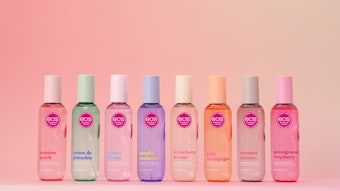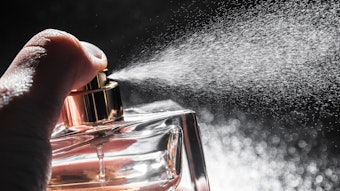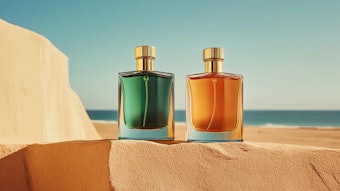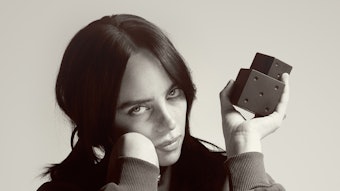IFF perfumer Christophe Laudamiel recently created scents for the main conference halls of the World Economic Forum. GCI magazine asked him about the process, expanding roles for perfumers, creating scents that don’t live in a bottle or on individuals, evolving avenues for “delivering scent and working with nontraditional scent clients.
How many individual scents were created for the World Economic Forum? Can you briefly describe each of them and perhaps some of the novel materials employed therein?
We created eight sets. Some of them are about the ingredients, and some are more about the concept—depending on purpose.
One is called Glacier—it was to create something cold, clear and crisp—and it was a tribute to shrinking ice caps. Happiness is to show what fragrances can bring to people and consumers in general. We know the strong link that exists between emotion and fragrances. This one was actually very citrus-y—a lot of citrus ingredients from Italy, for instance. Very bright and energetic.
The one which was designed that went into the plenary room was called Six Continents to symbolize the collaborative world—the theme for the WEF meeting was the power of collaborating/innovation. So here, I had a fragrance with different facets from different continents. And also, we were explaining that, in perfumery, we have had to collaborate since oldest times no matter the country, the people, race, the geography—whatever—because to create a fragrance formula, you have to have so many products from so many parts of the world. And it has been the big know-how of the fragrance industry. Which is quite unique for an industry. The fragrance industry always had to source from many different places.
One, Artemis, is to show how perfumery helps to protect the environment, plants, the people who grow the plants. Fragrance ingredients are very high value ingredients. So, when we use perfume, we are using high value ingredients. Also, they are usually local plants, so you are helping local [economies] at the same time.
Then we had one called Swiss Heights, it was like an homage to Davos (the Swiss city that hosted WEF). Some people called it the ‘older Davos.’ We had something very like the mountain air, the Alpine flower, fir trees... That was like a blink in the eye. Gigabyte is scent inspired by high-tech and optimism. In fact, this one Carlos [Benaim] I think this is had done for Visionare [an art magazine that has worked with IFF on novel flavor and fragrance projects] so we adapted it for room fragrances. It is this atmosphere of high-tech, and it is to show, that in fragrances we can recreate any kind of atmospheres. It is not just lavender fields or something.
Magnolia & Sage was to create the same kind of feeling as Gigabyte but with a different ingredient. So, to show how we play around with molecules (synthetics) and naturals. The last one, because we had to have a have an old classic of perfumery, that was my decision, was called Lavender Fields. For this one we used something special, an organic lavender essence, that LMR (Laboratoire Monique Remy) gets for us from Provence.
We had total freedom. All the themes and fragrances we decided ourselves. The WEF was very interested in integrating fragrance in their [sessions]. It’s not just artistic—it’s artistic and creative to show people what is going on on this planet. We gave sessions, but they also said we should do something to excite the people. They [had a visual exhibition], and they said ‘what could we do to showcase fragrances and olfaction?’
I sent the fragrances in advance for them to see that we were not putting out fragrances that people would say ‘what the heck is this?’ You have to be realistic. These are rooms were people are working, so I didn’t do anything controversial. It’s not a gallery—it’s a working environment, but with interesting themes. Then we went two days in advance to do all the trials; they had to have security approve it—the whole shebang.
The scents were very well in received, in fact, I was prepared to get some …you know, some people get negative, but I didn’t hear anything negative. Everybody that talked to me said it was very good idea, that it was very, very interesting. Some people found it interesting but were scared that others would react negatively, because it’s new – but no. I was very surprised about that. No one talked negatively about anything. You know, but when it’s explained, it becomes obvious that it should be this way. And we got support from WEF, to the highest level. Like anything new, it has to be approved of course, and this also gave credit to the whole thing. If the WEF is using it, it means there must be something behind it, it must be something serious, and it must be something worth looking at.
And it’s the way you do something, we were not there to advertise. It was there to show perfumery with a capital ‘p,’ and say ‘you know guys, you are at the forefront of a lot of new things, new messages , new ways of thinking… so here is something you have not looked into that is extremely important.’ When I spoke to the panel, they’d say ‘oh yeah, it’s true, we just never thought about it. We have to look into it.’ You can not ignore that people have an emotion and are reacting with a sense of smell. It’s part of life. The question is not, anymore, should we have it, it is part of our biology. The question is how should we do it, what is really exciting…These are the questions. You cannot argue [the point] should we have pictures or not, should we see or not, should we hear or not. It’s not a question. It’s part of life. It’s part of human beings. It’s part of our genes. How can we use [scent] more and in a very exciting way.
Can you name a couple of the novel materials employed in the creation of these fragrances that are of special interest to you?
We had several naturals and several molecules. We had, for instances, gentiane—it’s a plant that grows in the mountains. We had raspberry leaves—this is not much used in fragrance at the moment, real raspberry leaves—magnolia oil from China. We had a molecule called arctical, which is very clean, a little bit cold—not much used yet because it’s hard to use, I have to say. But it’s very unique.
The scents are described as “air sculpture” —to your thinking, how does this differ from a perfume? How was your creative process different?
First of all, because the way it is displace. You spray on skin and the fragrance is by itself for the next several hours. So you have to build it [for that purpose], whereas in the air, you have a machine that [delivers] fragrance in the air all the time. So [however the machine’s timing is set], you have fragrance released in the air. So it’s not about having a fragrance by itself, so the balance, for instance, of the top notes and then the long lasting notes are very different. In fact, you really don’t talk about the long lasting notes. They are there for what they smell like, not because they have to support the fragrance for several hours. If I use patchouli, for instance, it’s because it smells like patchouli not because it’s going to allow my fragrance to diffuse for six hours on skin.
So it’s very different kind of dosage. Through the machine, the fragrances diffuse very differently. Sometimes one facet of the fragrance pops out, and you go ‘oh my God, what is this doing here.’ When it’s a fragrance in the air, for me people who don’t realize it’s as complex... It is a piece art, or piece of design. And it is as complex as a piece of photography. [Visual art is] not just there because it makes the world look pretty. People like the fragrance because it smells nice, and it’s much better than other years because the rooms aren’t so stuffy, but I say ‘yeah, but you have to look a bit further. It’s not just something to smells nice, it is something designed so that you understand something.’ But people have to be trained. Just by the nose, they cannot build a world. They are not used to that. Like when they look at picture, they go much further than looking at the picture. They build a whole atmosphere from the picture, but they are not used to doing that with a fragrance. That’s why I chose the analogy of an air sculpture.
What are the challenges of creating scents that don’t live in a bottle or on individuals? People form deep attachments to their favorite fragrances, can you create the same kind of connections between a fragranced place and a person? Can a fragrance create or facilitate a connection between a person and a place?
Oh yes. And people ask us all the time... They say ‘Oh my God. Can you recreate that for me.’ Like for Chef Heston Blumenthal [The Fat Duck in London].
He wanted me to recreate the scent of his grandfather’s red leather sofa, with his grandfather smoking a pipe and it was Christmas time. So people are very strong memories of atmospheres. The scent of someone – someone they loved, or the perfume of their grandmother or the scent of a place.
People are very much into an atmosphere or a place. And they feel very strongly about that, and they would give a lot to re-experience these experiences. It’s a scent and it’s linked to memory.
How will perfumers’role change with these expressions of scent?
I think we will be asked to explore many more odor characters. A larger variety of thing than what we see today on the market. Today on the market, I’d say you see about 30% of what we can do with perfumery. There are a lot of older families that are not explored. So I think we will be asked to explore many more families in a very though way. And I think there will be more custom work. Because people get very passionate and personal, and many don’t even know what we can do – that we can recreate some things. Or to create something totally, you know, totally abstract, conceptual. I think we will be commission for a larger variety of work.










